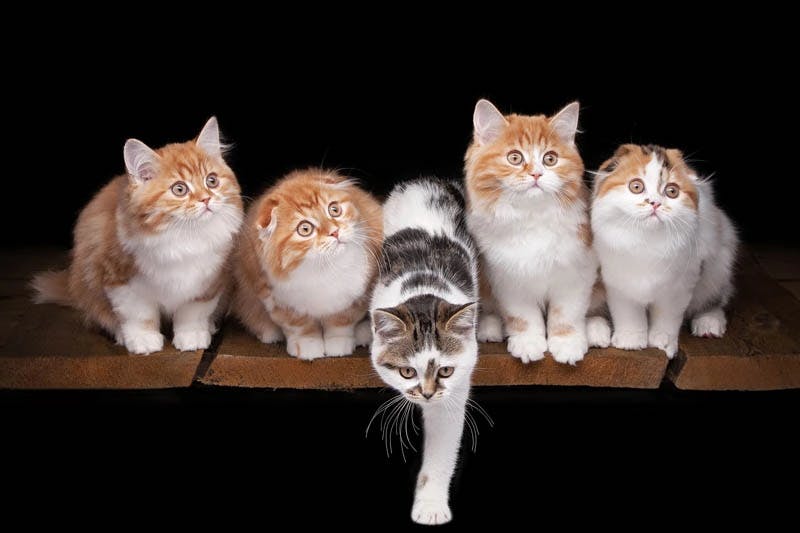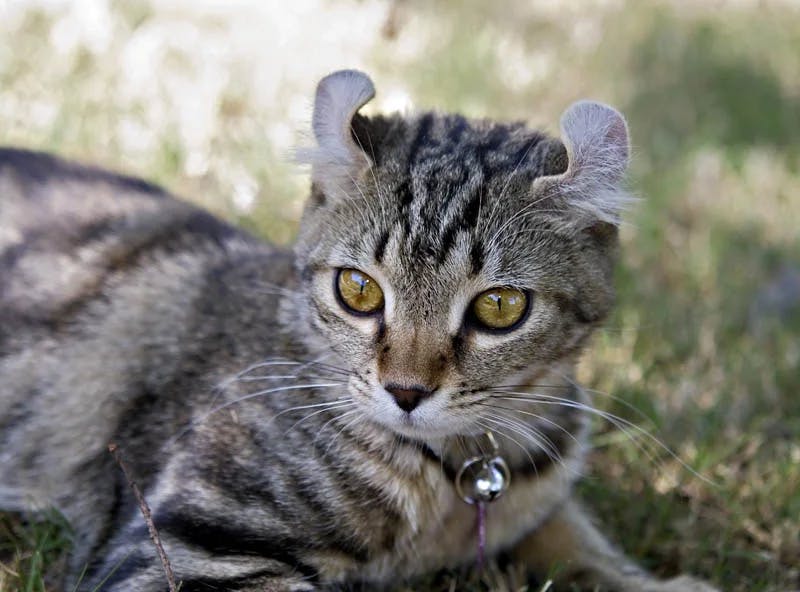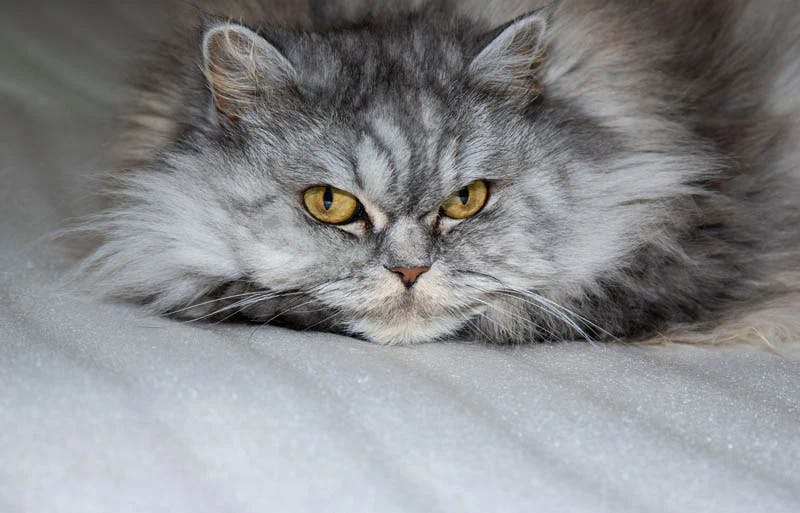Highlander Cat
A Rare New Breed with a “Big Cat” Look
Highlander Cat
Jon Crimes - Last Updated on December 18th, 2021
What you Need to Know about the Highlander Cat
The Highlander is an experimental and relatively rare breed of cat that comes in short and long-haired versions. It is also known as the Highlander Shorthair and Highland Lynx.
Highlanders don’t like isolation and they are very active cats who need interaction.
If you’re similarly active and are willing to play actively with your cat, as you would with a dog, then you should be rewarded with plenty of love in return.

Appearance Matters. What does a Highlander Cat look like?
The cat that looks like a Lynx! And common with the Lynx, the Highlanders ears are their most striking feature. They are very short and can be curled or straight, with the curled ears being caused by a dominant gene. Their eyes are wide-set, the forehead is long and sloping and they have an extremely wide nose.
‘Unusual looking’ is a good description for this stocky cat and its appearance is also complemented by an active lifestyle that results in flexible long hind legs and rippling muscles, with feet that are large and have prominent knuckles.
They have a naturally short tail which ranges in length from one inch to hock length (a shortened span extending down to mid-leg). The tail has a fat pad on the end and is thick and ideally straight.
This unique and striking look of the Highlander attracts immediate attention which serves to please the cat who prefers to be the center of attention.
Their coats can be spotted tabby, have lynx or solid point patterns, and come in the following colors:
- Sepia
- Mink
- Snow
- Blue
- Orange
- Cream
- Fawn
- Silver
- Ebony
- Bronze
- Chocolate
The spotted tabby or ‘leopard' pattern has a dorsal stripe running the length of the body to the tip of the tail.
The markings on the face and forehead are typical tabby markings, the underside of the body has distinct spots, and the legs and tail have a bar pattern.
‘Ghost’ leopard spots are the most popular body markings for the sepia, mink, and snow colorings.
How big do Highlander cats get?
They can grow to be truly big and powerful cats with large males weighing as much as twenty pounds or more!
This big and impressive appearance comes from crossing the Jungle Curl and Desert Lynx breeds yet despite this ‘big cat look’, the Highlander is an affectionate, friendly and playful cat and will thrive in a home where it can interact regularly with its human family.
It's all Personal. The Highlander Cat Character
The Highlander is a relatively quiet cat but has an abundance of energy. They are very active and commonly known as the ‘clowns’ of the cat world, where they love to play and chase things, even something as simple as a wadded-up piece of paper.
The Highlander is sometimes more like a dog than a cat and can be found expressing itself, enthusiastically, by wagging its unusual looking tail. Expect your highlander to play fetch, beg, roll over, and even like to be walked on a lead!
They also love human company, especially children, and will be there to greet you at the door and show off to your visitors.
They adjust well to other household pets and might be a good choice if you have other cats, dogs, rabbits, or other smaller animals. But Highlanders do have a very inquisitive nature and love water, so pet fish might need some extra protection if you introduce one of these cats into your family.
All this energetic activity helps build the powerful musculature that is so characteristic of this breed.

Caring for your Highlander Cat
Like all cats, Highlanders shed hair but the amount and grooming requirements depend on the length of their coats. Short-hair Highlanders will need occasional brushing to minimize shedding and prevent hairballs. For the longer-haired Highlanders, more regular brushing will be required.
Starting these sessions as a kitten will get them used to the brush and make the routine that much easier.
Other grooming activities to build into your Highlander routine include the eyes, ears, teeth, and nails. Most cats have natural discharge build-up in the corner of their eyes. Use a damp soft cloth to gently wipe this away on a daily or weekly basis.
They’ve only got small ears but they can still get dirty! Again use a damp soft cloth to clean away any dirt buildup but don’t stick anything in their ear canal. If you suspect an ear infection or you see/smell ear discharge then a trip to the veterinarian will be best.
Frequent teeth brushing will help to prevent gum disease and keep your cat’s teeth healthy and check your pet’s nails as part of your routine and trim if necessary.
The Health and Happiness of your Highlander Cat
Keeping your Highlander happy and healthy is fairly straight-forward. They are generally a very healthy breed and do not pick up illnesses quickly.
Keeping a close eye on your Highlanders coat, diet, and regular exercise is probably going to be enough to guarantee a very satisfied and healthy cat.
One thing to be aware of is that this breed does ‘suffer’ from polydactyly. This is where the animal is born with extra toes and is caused by a gene defect. But, for the most part, this ‘mutation’ is harmless to the cat’s health and happiness with the only downside being more nail trimming.
Health issues to look out for that are not breed specific and affect all cats include:
- Hemophilia B. This is a rare blood disorder that is said to affect some short-haired cats and should become apparent from a young age (6 months). Look out for prolonged bleeding from injuries or trauma.
- Obesity. Highlanders don’t generally need any special dietary schedule but keep an eye on their weight, especially if they are getting ‘extra’ food elsewhere.
- Hypertrophic cardiomyopathy. This form of heart disease results in the thickening of the heart muscle. This can be difficult to detect without veterinarian interaction but some symptoms include excessive panting, lethargy, and loss of appetite.
So how long do Highlander cats live? Keep your cat healthy and you’ll expect an average lifespan of between 10 and 15 years old.
How Much Can You Expect to Pay For a Highlander Cat?
These rare cats can be wonderful pets, which is why many people are out to get one. You must be one of them as well, and you could be wondering about the price of a Highlander cat?
Well, depending on several factors, expect to pay between $800 and $1,000 for a Highlander kitten for sale. This is the price you will see at reputable breeders.
Despite their rarity, highlander kittens aren’t that expensive, which is great news for all future owners.

Feline History. Where does the Highlander Cat come from?
The Highlander is a relatively recent breed with its development starting in 2004. Originally called the Highland Lynx, breeders settled on the Highlander in 2005 and set about defining the breed and its characteristics as they worked toward championship status in The International Cat Association (TICA).
Unlike the development of the Desert Lynx cat, the ‘Highlander’ didn’t involve breeding with wild cat genes and the name is meant to describe a domestic cat with a powerful ‘big cat’ look.
Selective breeding has contributed to protecting the Highlander’s unique features and enhancing the bloodlines, with the cats used to develop the breed being carefully chosen from the general domestic gene pool and not from any existing recognized breed.
TICA recognized the Highlander for competition in the Preliminary New Breed class starting May 1st, 2008.
